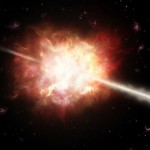Gamma ray burst provides glimpse to origin of the universe
A gamma ray burst in the farthest reaches of the universe may hold the key to understanding how the cosmos was born.
NASA researchers said Wednesday that a gamma ray burst 13 billion light years away is a rare event to "witness" - 1 out every 1,000. This particular explosion was first seen on April 29, 2009 by the Swift satellite. Scientists led by Andrew Levan then compiled and analyzed data over the next several months before coming up with an accurate date in time when it happened.
Because the date is close to what scientists believe is the age of the known universe, the gamma ray burst can give clues as to how the universe started. Already, scientists have discovered that even in its early years, stars have started to die and become black holes. During this process, massive amounts of energy are produced in just a few seconds or minutes.
Unlike a supernova which bursts towards all directions, a gamma ray burst shoot a column of intense light and energy on opposite sides of the dying star.
The paper detailing the study was written by Antonio Cucchiara of the University of California, Berkeley and will be published at a future issue of Astrophysical Journal.
Because of the fleeting moment, scientists who detect a gamma ray burst are in a race against time to capture and understand what they can before the phenomenon is over.
Levan's work is considered promising but other astronomers are skeptical because of the scant data collected over such a vast distance. But they agree that the gamma ray burst study is an exciting step toward understanding the cosmos.
